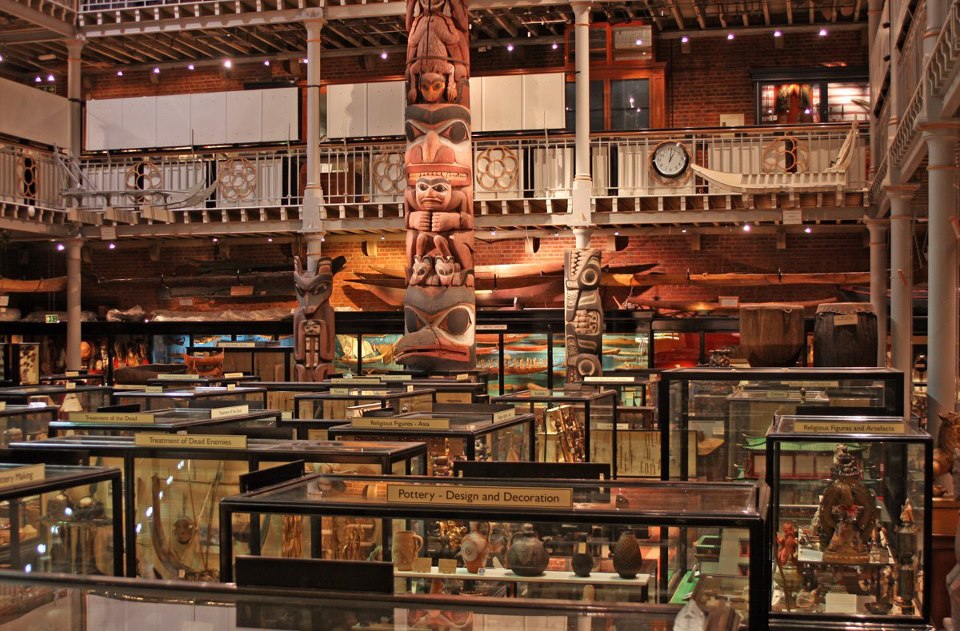Political Feelings
The Purest Kind of Ideology
“Political Feelings” is a bi-monthly column by Patrick Blanchfield about stories, scenes and studies of religion in American culture. This month: A conference about "Religion, Society, and the Science of Life"

Pitt Rivers Museum Facebook Cover Photo
The organizing principle for the collection at the Pitt Rivers Museum in Oxford, England is simple: everything. Spawned from the personal collection of a pioneering 19th Century British archaeologist and ethnologist, Augustus Pitt Rivers, the museum contains well over half a million artifacts.
Spread on multiple levels throughout a cavernous structure attached to the Oxford University Museum of Natural History, these objects are arranged not by region of origin or era of construction, but instead categorized by use, as artifacts of different domains of human life, indexing various (ostensibly universal) activities and interest. A case labeled “Treatment of the Dead” thus includes both Victorian urns and Shinto shrines, Andaman skull relics and Medieval European memento mori; it sits beside another case (“Treatment of Dead Enemies” with similarly far-flung contents. And there are hundreds of such displays, encompassing a bewildering archive of human pursuits and proclivities: Whistling Arrows, Smoking and Stimulants, Bells, Rattles, and Xylophones, Puppets, Skis, Model Boats, Snuff-Taking Equipment, and Lutes. The collection of religious artifacts is particularly astounding: totems, idols, ritual masks, incense braziers, ritual knives, prayer rugs, sacred jewelry, etc. Amidst this profusion of objects, variously “primitive” and high-tech, are also a variety of scientific instruments: telescopes, microscopes, slides, dissection tools. Alongside all the rest, their presence makes a point that is simple yet profound: scientific inquiry, like religious devotion, is a human phenomenon and a material practice, something humans do that involves things that humans make. Their metaphysical propositions and disputes over descriptive accuracy set aside, science and religion are presented together, first and foremost as grounded in a shared materiality.
But this even-handed emphasis on science and religion’s shared grounding also disguises implicit hierarchy. Pitt Rivers was a devout adherent of Charles Darwin and Herbert Spencer, a man who believed not just in assessing the adaptations and fitness of animals, but of weighing the superiority and decay of cultures and “the races.” Just because the display objects lie together, side-by-side does not mean they are equivalent – in fact, quite the opposite. They are artifacts of cultural adaptation and decline, and their proximity is meant to illustrate evolutionary narratives of improvement or stultification. Tracking these narratives was something the polymath Pitt Rivers saw as demanding dedicated interdisciplinary study, combining ethnology and anthropology and archaeology. It was also raison d’etre for his collection, and his museum. As he wrote:
The ethnologist and the anthropologist who has not studied the prehistoric archaeology of his own country compares the present condition of savages with that of the Europeans with whom they are brought in contact. He notices the vast disparity of intellect between them. He finds the savage incapable of education and of civilization, and evidently destined to fall away before the white man whenever the races meet, and he jumps at the conclusion that races so different in mental and physical characteristics, must have had a distinct origin, and be the offspring of separate creations. But the archaeologist traces back the arts and institutions of his own people and country until he finds that they once existed in a condition as low or lower than that of existing savages, having the same arts, and using precisely the same implements and weapons; and he arrives at the conclusion that the difference observable between existing races is one of divergence, and not of origin; that owing to causes worthy of being carefully studied and investigated, one race has improved, while another has progressed slowly or remained stationary.
Note Pitt Rivers’ phrasing about scholars comparing “the present condition of savages with that of the Europeans with whom they are brought in contact.” Pitt Rivers was a distinguished military officer, with a particularly keen interest in weapons; in his museum, walls of clubs and swords give way to muskets and then rifles. “Contact,” it seems, includes a lot of conquests – the outcomes of which vindicated white racial superiority. Quite un-self-consciously, Pitt Rivers’ museum was intended as a scientific archive of, and monument to, a global colonial empire, erected in the most erudite precinct of its metropolitan heart. The objects may share space in the same glass display cases, but what both separates and contains them is the purest kind of ideology.
Last July, not far from Pitt Rivers museum, at St. Anne’s College, a group of scientists, scholars, and clerics gathered together for a conference hosted by Oxford University’s Ian Ramsey Centre for Science and Religion by the Templeton Foundation and the International Society for Science and Religion (ISSR). The meeting, “Religion, Society, and the Science of Life,” focused primarily on the implications of what has become known as “the New Biology.” As many of the conference participants and organizers quickly stipulated, the phrase “New Biology” is something of a misnomer, less the name for a new kind of discipline than it is a shorthand for a variety of new tools. These tools are hard to describe, let alone imagine fitting coherently in a museum display case. Technologies like CRISPR sequencing have allowed biologists to precisely edit gene sequences in specimen organisms, producing particular, quantifiable effects in terms of the expression of various traits; meanwhile, new techniques for exploring epigenetics have expanded scientific scrutiny into an entire register of heritable characteristics that operate at a level just above DNA itself. The adoption of these tools has help prompt a recent revival of what’s known as the Extended Evolutionary Synthesis (EES), a sort of grand-unifying working model for the evolution of living organisms that attempts to combine classical Darwinian and more recent evolutionary theory with new experimental data. In the words of Massimo Pigliucci, a proponent of the EES and one of the conference’s major speakers, these developments together mean that the idea of “life as an object of study” has undergone a distinct and dramatic change.
 More granularly, a running theme through presentations and talks was how New Biology might affect, first and foremost, thinking about causality, and, second, undoing ideas of static organismic integrity in favor of multi-causal, interdependent systems. Dame Ottoline Leyser, a plant biologist and Professor of Plant Development at the University of Cambridge, illustrated this shift in perspective by asking her audience to consider a common specimen plant: the thale cress (Arabidopsis). Per Leyser, both scientific and popular considerations of such a plant inevitably proceed both in terms of linear narratives (from seed to plant, sprout to flower, etc.) and in terms of discrete levels of focus and scale (this is the function of the stem, this is the function of a petal, this is what roots do, etc.). Yet targeted interventions on the genetic and epigenetic level, reveal that linear narratives are insufficient, and that efforts at understanding biological processes at artificially constrained levels of scale fall short: organisms are dynamic, with their parts and environments in constant feedback with one another. “A cell is a dynamic self-organizing system of interacting molecules, sensitive to local and systemic inputs,” says Leyser. “And a meristem is a dynamic self-organizing system of interacting cells, sensitive to local and systemic inputs.” And thus: “A plant is a dynamic self-organizing system of interacting meristems, sensitive to local and systemic inputs.” Assessing her specimen plant as a specimen for an entire way of thinking, Leyser summed it all up: “The whole plant is a system that’s absolutely ridden with feedback, so I’m not that interested in [singular] causation.”
More granularly, a running theme through presentations and talks was how New Biology might affect, first and foremost, thinking about causality, and, second, undoing ideas of static organismic integrity in favor of multi-causal, interdependent systems. Dame Ottoline Leyser, a plant biologist and Professor of Plant Development at the University of Cambridge, illustrated this shift in perspective by asking her audience to consider a common specimen plant: the thale cress (Arabidopsis). Per Leyser, both scientific and popular considerations of such a plant inevitably proceed both in terms of linear narratives (from seed to plant, sprout to flower, etc.) and in terms of discrete levels of focus and scale (this is the function of the stem, this is the function of a petal, this is what roots do, etc.). Yet targeted interventions on the genetic and epigenetic level, reveal that linear narratives are insufficient, and that efforts at understanding biological processes at artificially constrained levels of scale fall short: organisms are dynamic, with their parts and environments in constant feedback with one another. “A cell is a dynamic self-organizing system of interacting molecules, sensitive to local and systemic inputs,” says Leyser. “And a meristem is a dynamic self-organizing system of interacting cells, sensitive to local and systemic inputs.” And thus: “A plant is a dynamic self-organizing system of interacting meristems, sensitive to local and systemic inputs.” Assessing her specimen plant as a specimen for an entire way of thinking, Leyser summed it all up: “The whole plant is a system that’s absolutely ridden with feedback, so I’m not that interested in [singular] causation.”
The idea of organisms as dynamic systems, and an emphasis on multi-factorial, interdependent processes rather than on singular causation was what, for most of the conference’s participants, activated the most religious resonances. Rather than upsetting many Western theological visions that emphasis God as First Cause or Prime Mover, the insights of the New Biology are taken as instead validating that premise. As Fraser Watts, an Anglican cleric and one of the event’s ISSR organizers put it, “For a Christian thinker, the living world seems increasingly to reflect the interdependence of Father, Son and Spirit.” Per Watts, the “holistic approach” of the new biology “takes a huge number of variables and tries to understand how they work,” thereby sidestepping tired debates over “monocauasal determinism.”.[1]
As the event proceeded, a certain ambiguity became visible. Although many participants would, in Q&As and casual conversation, attest to specific religious commitments, actual expressions of belief were kept to a minimum coming from the podiums. In fact, one of the most striking things in the first two days of dozens of talking about evolution in causality is that I never once heard the word “God.” And yet God was also ubiquitous – and not just God in the abstract. The implicit point of reference was, throughout, a very Christian, even specifically Protestant, notion of God as a Creator, with a plan for creaturely life and human transformation. The ISSR’s logo may feature symbols for a variety of traditions (the Star of David, a Sikh khanda, a Sanskrit om) but at this event at least there wasn’t much interrogation of how these traditions might frame the stakes of a “religion” versus “science” encounter differently. When one of the few Buddhists at the event did raise a post-lecture question, saying how, in his view, the world might be seen less as a dynamic system or divine creation than as “a torture device” intended to produce suffering, the response was sort of a sympathetic befuddlement. Interventions that did not deploy configurations of the discussion’s two operative dialectical terms – science on the one hand, and religion (read: Christianity) on the other – simply did not appear to compute.
 But Christianity was not the only theme that was ubiquitous yet unspoken, determining certain dialogue outcomes even as it foreclosed others. What was also everywhere, but unspoken, were politics and money. As an event funded by the Templeton Organization, this conference depended on the largesse of an organization with a history of specific political commitments and policy agendas. Speaking off the named record, several participants stressed that support for conservative religious causes were no longer part of the organization’s culture, and that the independence of this event from any such considerations was sacrosanct. Yet, regardless, as with not naming God, the discussion of “dialogue” between science and religion proceeded without naming any of the material dimensions that made it possible in the first place. In one of the capstone lectures, a noted theologian and public intellectual described today’s youth as plagued by a sense of disconnection, a yearning for meaning and answers. This anomie, he suggested, meant millenials were a ripe audience for the insights of religious figures working in dialogue with scientists. When the question arose as to how those youth’s unhappiness might also relate to political uncertainty and their economic fortunes, consideration of how that might be germane was deferred in favor of starting “conversation.”
But Christianity was not the only theme that was ubiquitous yet unspoken, determining certain dialogue outcomes even as it foreclosed others. What was also everywhere, but unspoken, were politics and money. As an event funded by the Templeton Organization, this conference depended on the largesse of an organization with a history of specific political commitments and policy agendas. Speaking off the named record, several participants stressed that support for conservative religious causes were no longer part of the organization’s culture, and that the independence of this event from any such considerations was sacrosanct. Yet, regardless, as with not naming God, the discussion of “dialogue” between science and religion proceeded without naming any of the material dimensions that made it possible in the first place. In one of the capstone lectures, a noted theologian and public intellectual described today’s youth as plagued by a sense of disconnection, a yearning for meaning and answers. This anomie, he suggested, meant millenials were a ripe audience for the insights of religious figures working in dialogue with scientists. When the question arose as to how those youth’s unhappiness might also relate to political uncertainty and their economic fortunes, consideration of how that might be germane was deferred in favor of starting “conversation.”
After four days of conversation, always positioned as conversations started towards opening-onto yet other, future conversation-to-come, it soon became clear: this was the purpose of the exercise, this was that conversation. An abstract dialogue between two abstractions (“religion” and “science”) as a dialogue meant, in practice, the interaction of representatives of various institutions (the academy, and certain specific established religions) obliged to continuously talk around the structures (capital, politics, disciplinarity) that were the conditions of possibility for the dialogue itself.
The conversation was certainly fascinating, and the atmosphere cordial, but it all felt, in its own way, on display, framed by and for a particular ideological gaze, an artifact of some obscure cultural purpose, in its own ideological glass case.
***
[1] Not that certain types of determinism were entirely absent from the event: over lunch one day, a PhD student working in the philosophy of mind explained that in addition to being a Calvinist, he’s also a biological determinist. In other words, in his view, human are robots, all the way down and some of those robots are programmed to be the Elect while others, not so much.
***
Patrick Blanchfield was the 2016-2017 Henry R. Luce Initiative in Religion in International Affairs Post-Doctoral Fellow at the Center for Religion and Media at NYU. He holds a PhD in Comparative Literature from Emory University and is a graduate of the Emory University Psychoanalytic Institute. He writes about US culture, guns, and politics at carteblanchfield.com and is on Twitter as @patblanchfield.
***
Published with support from the Henry R. Luce Initiative on Religion in International Affairs.